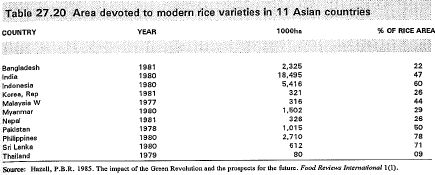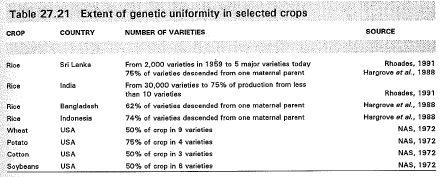So, Olivier de Schutter, the UN Special Rapporteur on the right to food, who teaches at the University of Louvain in Belgium and Columbia University in the United States, has been talking to reporters about the dangers of genetic erosion:
He noted that in Sri Lanka in 1959, for example, some 2,000 varieties of rice were cultivated, whereas today, there are fewer than 100, and some 75 per cent of agro-biodiversity has been lost as a result of the pressure towards to the adoption of uniform improved seed varieties.
We know where the 75% figures comes from, and that it is, frankly, rubbish. What about the other two?
Two thousand Sri Lankan landraces is not implausible. There are 2028 rice landrace accessions in the IRRI genebank, 25 of which have georeferences. So, with various caveats, if I didn’t have any other information, I wouldn’t feel too uncomfortable about using that number for the pre-Green Revolution diversity of rice in that country.
But actually there is other information. The full version of de Schutter’s report, which he kindly sent us, had a reference for the number 1, and thanks to our friend Maria Garruccio at the Bioversity International library we tracked it down. It in turn gives the number as coming from Part 2 of the book “Uses and Values of Biodiversity,” under the section “Biodiversity and Economics,” pages 426-427. The information can be found in a couple of tables.


So that sent us to R.E. Rhoades‘ 1991 article in National Geographic “The world’s food supply at risk” 2 This is a new one on me. Here’s the relevant bit:
In Sri Lanka, where farmers grew some 2 ,000 traditional varieties of rice as recently as 1959, only five principal varieties are grown today. In India, which once had 30,000 varieties of rice, more than 75 percent of total production comes from fewer than ten varieties.
Alas, there’s no reference given for those numbers, but I’m pursuing this further. Prof. Rhoades is not listed as a rice donor to IRRI, though he did work at CIP for some years. But his companion during his trip to Sri Lanka for National Geographic, Balendira Soma Sundaram 3 is, according to IRRI’s databases, a collector of 257 accessions from 3 IRRI collecting missions to that country (1979, 1984, 1988). So he should know.
Incidentally, some 60 improved rice varieties have been released in Sri Lanka since 1964 again according to IRRI’s database. INGER monitors such things.
It’s not just a few figures that are rubbish, but the (almost) entire discourse.
De Schutter takes us some thirty years back, to the prehistoric times of plant genetic resources activism based on misconceptions over seed certification, variety listing and plant breeders’ rights.
He has likely been seduced by entities which trade in ‘traditional’ seeds, mainly of vegetables, in France and resist the legislation which imposes upon them an obligation to have the traded varieties properly maintained and registered and the seed produced according to state-of-the art standards and certified. This may have happened through a farmers’ union, Confédération paysanne, and Via Campesina.
The report to the United Nations General Assembly is, to that extent, an instrument at the service of one particular cause in one particular (developed) country. Furthermore, developing countries are taken hostage to that cause. The odd thing here is that the French Government has adopted specific provisions for the registration of heirloom varieties… For more, if you read French and here. This is particularly interesting because it shows what ‘hackers’ disguised as farmers or conservationists can do when enough space has been allowed or, worse, created for them to engage in commercial activities.
It may be that the above manipulation theory is not (entirely) correct. Suffice it to note, then, that many countries – starting with the United States of America – do not have the kind of seed legislation that are central to the argument put forward in the report (this not implying that the report correctly assesses – on the contrary – the effects of, say, the European seed legislation).
Coming back to the press conference, if one had to encapsulate de Schutter’s thesis in one sentence, I would say that he comes pretty close to lamenting the fact that States (and for that matter also the CGIAR centres) adopt measures to improve agricultural and food production, and the livelihoods of farmers. “However – and my emphasis here is in the word ‘however’, and also ‘genetically improved’ – there is increasing pressure for farmers to use more uniform, genetically improved commercial seed varieties”, it is reported…
The report on the conference is full of fallacies. Consider for instance: “The commercial seed system might also be a threat to agro-biodiversity, Mr. de Schutter warned, noting that today, there were barely 150 cultivated crops. Genetic erosion was a source of vulnerability and agro-biodiversity could be a source of resilience against the impacts of climate change.” Beyond the ‘might’s and the ‘could’s, it is quite upsetting to see that arguments are based on a confusion between species (or crops), varieties (and cultivated populations), etc.
Furthermore, one can only be puzzled by the reference to “the debate about organic versus genetic-based farming”.
To conclude with a bit of acrimony and bitterness, the talk on the Right to Food requires a prior walk through the basics of Agriculture.
André: thanks for your input. I’m not going to attempt to address all the points you make, although there is one on which I would be grateful for your views. What is the justification for a single set of seed regulations designed for and with large commercial farmers, which does not meet other growers’ needs?
The situation in the EU is, as far as I know, unique in the world. Anything not registered is not permitted to be marketed, not even exchanged. And the fixed cost for registration makes it uneconomic for varieties with small sales to be registered. Even the French and other systems for “heritage” and “conservation” varieties do nothing to encourage breeding for small-scale and home growers today.
In other countries, people have a choice. They can buy registered seeds, which may be produced in the way you claim, or they can choose to obtain seeds from other sources in other ways, caveat emptor but with recourse to normal consmer protection legislation.
Why, in your view, is Europe’s position preferable?
I do not think there is a basis for suggesting, which appears to be the idea, that the 2,000 ‘traditional’ varieties of rice represent more diversity than the current 100 (on the contrary, new varieties more often then not contain exotic genes); and that this would imply a risk to food security.
75% of those varieties descended from one maternal parent, according to the second table. So a lot of exotic fathers should be involved…
Diversity on Sri Lanka probably went up, probably. But global diversity goes down when landraces are replaced with modern varieties. Some Sri Lankan alleles will be ‘exotic’ worldwide.
Rhoades wrote articles for National Geographic more than once.
1993 Corn: The golden grain.
1991 The world’s food supply at risk.
1982 The incredible potato.
My favourite is, of course, the 1993 item. It has an impressive picture of a farmer carrying maize with a tumpline near Lake Atitlan.